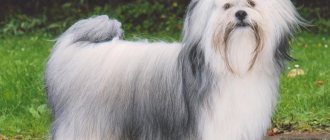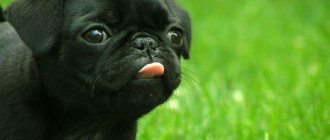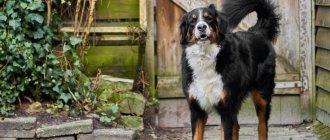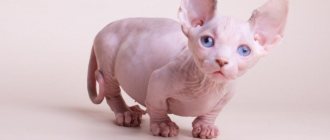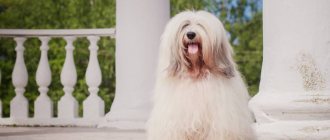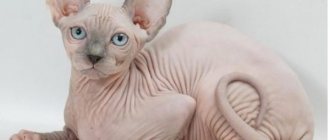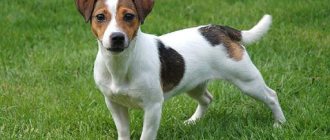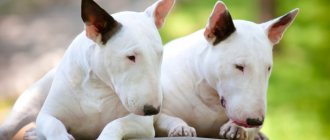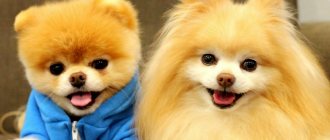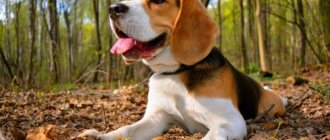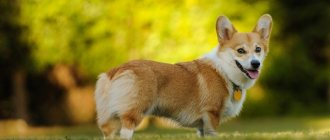Video
* We invite you to watch a video about the Chow Chow . In fact, in front of you is a playlist in which you can select and watch any of 20 videos about a given dog breed by simply clicking on the button in the upper right corner of the window. In addition, the material contains quite a lot of photos. By looking at them you can find out what a Chow Chow looks like.
In this article:
|
Rate the material!
[Total votes: 1 Average: 5]
The Chow Chow is one of the most ancient dog breeds. Human imagination has awarded this dog with a variety of comparisons: dog-bear; the dog that licked the edge of the sky; lion dog The breed appeared in China more than 2 thousand years ago. At first, these dogs were used as hunting, guard, and fighting dogs. Today it is a wonderful friend and companion of a person, who has retained in the depths of his soul all the best features and qualities of his distant ancestors.
Care and maintenance
A Chow Chow baby needs a walk to teach him to be neat; the puppy is taken outside several times a day , trying to ensure that there are as few puddles at home as possible. Chow chows are very clean, and after a while the pet will begin to ask for food on its own.
After mandatory vaccinations, the puppy is walked four times a day, trying to ensure that one walk lasts at least an hour. In the process of walking on a leash, the baby not only strengthens his muscles, but also begins to explore the world.
A small chow chow can live in an apartment until he is six months old . After this age, the teenager can be transferred to an enclosure with good drainage for water outflow and a canopy for protection from rain and sun.
Long-haired babies begin to be firmly and persistently taught to comb, regularly bathe and blow-dry. In summer, you should not leave your pet's fur wet , otherwise the skin underneath will begin to rot. Drinking water should be in a special bowl to prevent any remaining liquid from dripping onto your neck.
History of the origin of the Chow Chow
According to the classification, the breed belongs to the Spitz group. However, there is a theory that these dogs have some admixture of Tibetan Mastiff blood. There are several versions about the origin of the breed. According to one of them, the first Chow Chow dogs were presented to the Chinese Emperor by the Mongol conquerors as a guarantee of peace. It is believed that these dogs came to the Mongols in the form of war trophies from the peoples of Siberia, and archaeological finds fully confirm this fact.
As for the genetic roots of this breed, the question remains open to this day. Some experts believe that the breed originated from polar wolves. At the same time, the indigenous peoples of Siberia still have a legend in circulation that Chow Chows were obtained from crossing two completely different species of animals: a polar bear and a husky.
Interesting fact: In China, these dogs were initially kept only in the homes of local aristocrats. Over time, the fashion for Chow Chows passed, they spread throughout the country and, naturally, no one controlled the purity of their blood. However, things were not entirely bad. It turned out that Buddhist monks in some monasteries in Northern China, Manchuria, and Tibet managed to preserve the breed, leading the pedigrees of black and blue Chow Chows for centuries.
In Europe, “bear” dogs appeared in 1780 and at first were considered nothing more than a popular curiosity. The position of dogs in Europe changed dramatically in 1865, when Queen Victoria was given a Chow Chow puppy as a gift. The Queen was literally fascinated by the fluffy miracle and issued a decree on the breeding of these wonderful dogs. In 1887, the British officially began breeding this breed, and within 8 years the first specialized club appeared in Europe.
In Russia (in the Far East), Chow Chow dogs first appeared in Soviet times - about 80 years ago, they were probably imported from China. Later, after the end of the Great Patriotic War, in 1945, several dozen dogs were brought to the USSR from Germany. As for the stable Chow Chow population, it formed in the USSR somewhere in the 60s of the last century. In 1976, purebred Chow Chows were brought from Tibet to the Leningrad Kennel Club.
How to choose?
People who want to buy a Chow Chow should not rush to buy a dog. First, you need to decide on the gender and color of your future pet.
Bitches have a softer character and are less likely to be stubborn than males . But boys of this breed look more impressive, and therefore future owners who want to successfully exhibit their pets should think about purchasing a male dog.
A girl is better suited as a family dog, since the innate maternal instinct makes bitches more favorable not only to puppies, but also to small children.
You need to purchase a dog through a club or kennel.
However, when choosing a nursery on your own, you need to remember that some of them are not included in the RKF, and, therefore, a chow chow purchased there cannot be shown at all exhibitions, including international ones.
NOTE!
Buying a dog on the market and without documents of origin is fraught with the risk of purchasing not a chow chow at all, but a mixed breed or a mongrel puppy.
When choosing a future pet, you need to remember that it must be healthy, well-fed and moderately mobile. Excessive slowness, as well as excessive fussiness, can be signs of a not very good psyche.
The color of a small Chow Chow can differ noticeably from the color of an adult dog, so, first of all, you need to focus on what the parents of the chosen baby look like.
After all, the puppy will most likely inherit the color from one of them, and not from a more distant ancestor.
Chow Chow - description of the breed
This breed is one of the most recognizable in the world. The amazing appearance of the Chow Chow, similar to both a lion and a bear, has become the reason for the considerable popularity of the animal. The height of an adult dog at the withers: male - up to 56 cm, female - up to 51 cm. Weight: male - up to 32 kg, female - up to 27 kg.
The dog's skeleton and body are powerful, the tail is set high. The feet are straight, small, a bit cat-like, slightly rounded and raised at the toes.
The Chow Chow's head is wide, somewhat flat with a vaguely defined stop. The muzzle is of medium length, blunt, without a point. The nose (lobe) is quite large, wide, usually black. In light-colored dogs (fawn, blue, cinnamon), the color of the lobe is lighter, usually matching the color of the coat. Lips, palate, gums, tongue - blue-black.
The dog's eyes are medium-sized, oval-shaped, usually dark, and the pupil is clearly visible. Lighter-colored dogs may have eyes that match the color of their coat. The ears are quite thick, somewhat bear-shaped, and rounded at the ends. The neck is not short, quite powerful.
The Chow Chow's coat is quite thick. The coat is erect, fairly long, coarse with a soft, thick undercoat. There is a characteristic mane around the neck, giving the dog some resemblance to a lion. Long woolen pants are clearly visible on the back of the thighs.
The coat color of dogs of this breed is always uniform and quite varied - white, blue, cinnamon, red, fawn, black. Among them, white and blue are the most valuable. At the same time, according to the standard, shades of the main color are allowed, but spots are never allowed.
Breed standard
The general conformation is characterized by a stately, lion-like appearance, compact build and stilted gait. Adults weigh 20-33 kg . with a height of 46-56 cm .
The large head rests on a powerful, slightly curved neck. With rounded ends, small ears are slightly inclined towards the eyes and slightly brought together. Because of this, it seems that the dog is unhappy and frowns all the time. The muzzle is wide, pointedness is not allowed. Oval eyes are not too large, dark. The jaws are powerful and have a scissor bite. A unique feature of the breed is its blue-black tongue.
The back is short, the chest is voluminous. The tail lies on the back. The limbs are straight, not too long, muscular. The paws are not large and have a rounded shape, they look like a cat's.
There are short-haired and long-haired varieties, with the second option being the most popular and well-known. In both cases, the coat is double, there is a dense and soft undercoat.
1. Short-haired type (smooth) - the coat has a plush structure, the length is much shorter than that of long-haired individuals, dense, not lying flat. 2. Long-haired type - the coat is long and thick. The guard hair has a coarse structure. There is a lush collar around the neck, creating the appearance of a lion's mane. There are featherings on the tail and back of the thighs.
It is prohibited to artificially shorten the hair of both long-haired and short-haired animals; the coat should be as natural as possible. Although some owners like to trim their pets in the warm season. During this procedure, the likeness of a small lion is created. The fur on the tail, paws and head is left longer, resulting in a lion-like appearance.
The color is allowed pure and with shades. Spot coloring is not allowed. The colors are as follows: blue, black, white, red, red, cinnamon, cream.
Popular Chow Chow colors
Regarding the length of the coat and its structure, dogs are divided into two types:
- Long-haired;
- Shorthair.
Long-haired Chow Chows have a rather long and very thick coat with an equally thick undercoat. At the same time, the hairs themselves grow almost vertically. The fur mane on the neck and the “pants” on the hind thighs stand out well. Short-haired Chow Chows include smooth dogs.
They, in turn, come in two types:
- With sparse guard hairs and thick, literally stuffed with plush undercoat. At the same time, the guard hairs look longer, but do not stand out too much, and the fur itself is soft and fluffy;
- With short guard hairs and equally short undercoat. This coat looks shorter and smoother.
According to the international breed standard, the coat color of the Chow Chow can be as follows:
- White;
- Blue;
- Black;
- Cinnamon (cinnamon);
- Red (red);
- Pale yellow.
It is worth noting that shades of primary colors (both lighter and darker) are quite acceptable and are not considered a deviation from the standard, but the color of the entire coat must be uniform, without any spots or other inclusions of a different color.
The most popular colors of these dogs among ordinary dog breeders today are red and cinnamon. Even a Google search engine's search results in ninety percent of cases showing these colors. Moreover, among true connoisseurs of the breed, the most valuable and, accordingly, the most expensive are the white and blue colors.
Health and major diseases, life expectancy
The average lifespan of a Chow Chow is 9-15 years .
These dogs have fairly good health, but there are some diseases that are most often diagnosed with them.
Such pathologies include:
- obesity;
- inversion and inversion of the eyelid;
- joint dysplasia;
- volvulus;
- hypothyroidism;
- glaucoma;
- diabetes;
- tumors;
- allergy;
- myopathy;
- dermatitis.
It is necessary to carefully choose a puppy, since many diseases are hereditary.
Character and habits of the Chow Chow
Chow Chow dogs are independent, strong-willed and very self-confident animals. They often show a tendency to show their superiority over other animals and can even show aggression towards them. For this reason, such a feeling as tolerance and tolerance must be cultivated in dogs from puppyhood.
Once in a family, the dog chooses its owner, and treats the other members tolerantly, friendly, but nothing more. Chow Chows are completely indifferent to children, but they will not tolerate children’s bullying either. Therefore, if there are children in the family, especially small ones, in order to avoid trouble, you should carefully monitor how they communicate with the dog and nip in the bud incorrect actions on the part of both the dog and the children.
Solid training for such a dog is simply necessary. A real owner must show the dog his leadership. Only in this case will the pet take into account the owner’s opinion and completely obey him. Chow Chows carry out commands very reluctantly, thinking about everything for quite a long time and making a decision. At the same time, dogs of this breed are quite calm, sensitive, and delicate.
Interesting fact: The dog chooses its place in the house, as well as its owner, and changes it quite often. At the same time, she must see everyone and control everything.
The dog is neat. For example, during a walk after the rain, she will avoid puddles so as not to get dirty. This cleanliness is explained by their dislike of water procedures. For this reason, Chow Chows must be taught to wash their paws from a very tender age.
Character and abilities
The dog is energetic and hardy, fearless and devoted to its owner, but is distrustful of strangers. Such a pet is ready to risk his life for the sake of a loved one, but he will not always obey him. By nature, Chows are calm, independent and freedom-loving, and also extremely stubborn. They are known for their tendency towards dominant behavior, selfishness and pride.
Read our article and you will learn about: How to show your dog that you are in charge? What are the causes and manifestations of dominant behavior in animals, how to deal with it and what to do if the dog is disobedient and aggressive? What is teenage rebellion in a dog? What breed is the most common for dominant dogs? What techniques are used to establish leadership in a relationship with a dog?
The Chow Chow is a low-emotional breed. The highest manifestation of love for these dogs is considered to bury their nose in the owner and mutter like a bear cub, and they express joy with a couple of tail swings. Chows bark extremely rarely and always to the point: if a domestic lion uses its voice, then the situation requires attention.
The dog is delicate towards the owner
Intelligence is average. The dog is curious, has a good memory, but due to its stubbornness it is difficult to train. She is not very sociable, as she is an introvert by nature. A small dog, as soon as it appears in the house, studies people, evaluates their behavior, attitude towards itself, and draws conclusions. The Chow will consider the owner only the one in whom he sees the leader, but will remain neutrally friendly towards the rest.
Relationships with children will not be easy. The chow is prepared to endure the importunity and tactlessness of little ones for only a short time. If this relationship is not regulated, the dog will avoid younger family members and is unlikely to make friends with them in the future. The dog perceives strangers with caution and distrust. A well-mannered dog will not show aggression, but he will not allow himself to be scratched behind the ear in his own way.
The chow is ready to endure the importunity and tactlessness of little ones for only a short time
As for birds and other pets, a representative of the breed only recognizes those with whom he grew up from childhood. The rest will either be annoying competitors or the subject of hunting. Chow Chows have a special dislike for strange cats. Even a well-mannered dog is difficult to keep on a leash if a mustachioed “evil” appears on the horizon. The animal is delicate towards its owner. He will not impose himself and demand attention, but he will always “pity” the owner and sympathize with him when he sees that he is upset.
There will be no friendship...
Dog experts advise getting a Chow during puppyhood, when he is best socialized and adapts. It will be more difficult with an adult dog. It is unlikely that it will be possible to retrain and re-educate him. In addition, experts do not recommend being rude or physically punishing your pet, even when it is at fault. This will kill trust and friendship, and will also seriously worsen mutual understanding with the dog. With proper attention, the Chow Chow makes an excellent companion - a family favorite, who will also be good as a guard and guard dog.
Interesting facts about Chow Chow
The Chinese legend about the origin of the breed says the following: The Chow Chow was next to the Creator when he created the world. The Creator allowed the dog to lick a piece of heaven at the exact moment when the stars were shining on it, and from this his tongue became bluish-black.
Chow Chow dogs appeared in the Old World thanks to the traveler Marco Polo, who was the first European to officially set foot on Chinese soil. Before this, China was a closed country.
During the rise of the breed's popularity in China, about five thousand Chow Chows were kept at the court of the Chinese Emperor. At the same time, the selection was quite cruel. Puppies that did not meet the standard were killed and their meat used for food. There is an opinion that this is where the tradition of eating dog meat came from.
Chow-chows are very smart dogs, simply intellectuals, so their owners need to carefully think through a set of daily activities. Otherwise, the pet simply will not want to constantly perform the same commands.
This dog breed has some training challenges. The main difficulties in this regard are typical when working with male dogs. Girls are considered more obedient and flexible. Dogs of this breed usually live from 9 to 16 years.
The level of distrust and anxiety in Chow Chows is slightly higher than in other breeds. For this reason, socialization is very important for dogs. She should know all the children, relatives, neighbors, guests.
Chow chows never stoop to barking just because. Dogs of this breed are distinguished by their cleanliness. They will never relieve themselves in the wrong place and will never get dirty during a walk, even if it is slush and rain outside.
Appearance
On the Internet, photos of Chow Chow dogs remind many people of plush toys. It’s not for nothing that in some countries they are called “shaggy lions.”
The breed is famous for its long, thick hair that resembles a mane. The color can be red, cream, black, blue or light beige.
Chow chows grow up to 56 cm, have a fairly balanced body and strong, straight limbs.Another feature of the breed is its purple tongue.
Pros and cons of Chow Chow
In addition to its beautiful and rather exotic appearance, the Chow Chow has many other advantages. But besides the advantages, it is also important to know about the disadvantages of the breed.
Advantages:
- Beautiful appearance;
- Obsessive cleanliness;
- Well-developed guard qualities;
- Has no tendency to bark just because;
- Delicacy, unobtrusiveness, sensitivity;
- Good adaptability to keeping both in the house and in the apartment.
Flaws:
- The desire to dominate both other animals and family members whom the dog does not consider its owner;
- Difficulties with education and training;
- Long-term maturation and formation;
- Difficult character;
- Tendency to show aggression towards other animals;
- Touchiness.
Despite the rather impressive list of shortcomings of the breed, with proper upbringing and timely socialization, Chow Chows turn into calm, gentle and obedient pets. Although, undoubtedly, the owner will have to be patient and put in a lot of effort. After all, it is known that the blood of guard and fighting dogs flows in the veins of these dogs, which means that somewhat aggressive behavior is quite normal for them.
Having gained a lot of patience, the puppy’s owner will first need to teach him the simplest commands: “no”, “come to me”, “sit”, “lie down”. When the puppy has learned all the commands, you can begin a training course, preferably under the supervision of an experienced dog handler. You should never shout loudly at a dog, or worse, hit it. The dog may harbor a grudge against the owner and even refuse to exercise.
Character of the breed
The Chow Chow is a dog with a very stubborn and complex character. Not everyone can be its owner. Her training and socialization should begin at an early age. The Chow Chow is a dominant breed that needs firm authority. So throughout her life she will know her place.
These are not noisy dogs. While walking, passers-by and other people's dogs should not bark. Dogs of this breed do not require long walks, so they can live in an ordinary apartment without any problems.
The Chow Chow loves to be alone and is a one-owner dog. Dogs learn to be clean very quickly.
Breeding Chow Chow
Breeding this breed should be approached with all responsibility. Especially if the goal is to obtain healthy breeding offspring that meet all standards and are able to take part in exhibitions in the future.
Puberty in Chow Chows occurs at 7-8 months of life, which theoretically allows them to begin breeding already at this age. Experienced dog breeders advise not to rush, especially for females. There are two reasons for this: psychological immaturity and a poorly developed musculoskeletal system.
The optimal age for breeding a Chow Chow is 1.5-2 years. The female in the most active phase of the cycle is brought (brought) home to the male for mating, and not vice versa. The main reason for this condition is that in their territory, males tend to be more active and, as a result, cope much better with the mission entrusted to them.
Important fact: Mating is usually carried out in the morning, before feeding, but after a good walk. The amount of extraneous irritants should be kept to a minimum.
Pregnancy in a female Chow Chow can be detected as early as the second month by changes in behavior and weight gain. Pregnancy lasts, like other dogs, approximately 60-65 days. It is clear that a pregnant female needs to be fed more often and better, carefully compiling a daily menu, and also taken for walks more often.
You need to prepare for childbirth in advance and it is better if this happens at home, in an environment familiar to the dog. There are not too many puppies in a litter - from two to four. The number of puppies also depends on the age of the female. At the same time, babies can be quite large, so that during childbirth sometimes the help of a veterinarian is required.
For a mother in labor and newborn puppies, it is better to prepare a large box with clean bedding in advance.
Chow Chow Care
The ancient ancestors of modern Chow Chows guarded the home of their owners. So, the best place to keep such dogs is a private house with a spacious yard where the animal can run around to its heart's content. All the owner will need to take care of is shelter from the sun and clean water, because Chow Chows cannot tolerate heat.
The maintenance of an apartment is also suitable for them, but in this case the owner’s housing should be quite spacious. It is also important to provide your dog with a daily walk. During the walk, active games and training are highly desirable. Dog handlers do not recommend letting the Chow Chow off the leash while walking. It’s just that dogs have a complex, unpredictable character, which is why she and her owner can find themselves in an unpleasant situation.
Species with long hair require regular coat care - combing with a special brush. If this is not done, then over time the fur will turn into large tangles from accumulated dirt and uncombed hairs. You need to brush your dog often - at least 4 times a week, and even better - daily, especially during shedding. With short-haired dogs there is somewhat less hassle. It is enough to comb them 1-2 times a week. In addition to the aesthetic result, brushing brings the Chow Chow very close to its owner.
In addition to caring for the coat, the dog needs to carry out hygiene procedures:
- Bathing;
- Eye and ear care;
- Teeth cleaning;
- Trimming claws.
Chow Chows should be bathed no more than once a month, using a special shampoo for thick coats. After bathing, it is advisable to dry your dog with a hairdryer. The ears and eyes are wiped 1-2 times a week with a cotton swab moistened with a special liquid, which can be bought at a veterinary pharmacy. The teeth are brushed with a special brush or given bones to clean the teeth. Claws are trimmed as they grow.
Advantages of the breed
- Beautiful dogs . Dense bone structure, mane like a lion, unusual color of the tongue - all this will definitely attract the attention of others. Furry Chow Chows are like teddy bears that you want to pet and scratch constantly.
- Unpretentiousness in food . Representatives of this breed can eat both dry food and food cooked by the owner. At the same time, of course, you should not feed your dog food from your diet, especially if it consists of insufficiently healthy food.
- Devotion to the owner . Chow chows, even without security training, will rush to defense if they see that the owner is in danger. He is also zealously ready to defend his home from uninvited guests.
- Low need for activity . Although the dog is quite large in appearance, and it seems that it will be cramped in the apartment, in fact this is not the case. Chow-chows are quite lazy, they do not feel an urgent need for constant serious exercise and four-hour walks.
- No serious maintenance required for appearance . The Chow Chow does not need to be cut, brushed once a week is enough, and washed only a few times a year. Their claws do not form tangles; with sufficient walking, their claws wear down on their own.
- Restrained and calm . Such a dog almost never barks or whines unless there is a serious reason for this. If he and his owner are not attacked, then on the street he usually does not pay attention to either other dogs or people.
- Clean . The Chow Chow's coat has a dirt-repellent property and also cleans itself from dirt. Even if the dog rolls in a puddle, after a while he will be clean again, even if he is not washed.
Chow Chow diet
As for the Chow Chow's nutrition and diet, their owners sometimes have difficulties with this due to the breed's tendency to food allergies.
Dogs are carnivorous animals, so meat must be a must in their diet. Turkey, beef, and lamb are best, but chicken should be given with caution. It is better not to give boiled small tubular bones to your dog, as they can injure both the gums and the esophagus. Raw bones (not tubular ones) are good for training your teeth and gums.
Also, twice a week, Chow Chow can be given boiled fatty fish: mackerel, herring, pink salmon. Dairy products are also useful for your pet: kefir, cottage cheese, fermented baked milk and eggs (boiled), as a valuable source of protein. It is clear that it is better not to offer purely “human” products to your dog: smoked meats, lard, chocolate, beans.
As for the diet, the rules for the Chow Chow breed are as follows:
- It is advisable to feed your dog at the same time and exclude any snacks. This way she will know when to eat and will not beg;
- Adult animals are fed 2 times a day, and puppies - 5-6 times a day. As the puppies grow older, the number of feedings is gradually reduced to 3-4, and then to 2 times a day;
- The basis of the Chow Chow's diet is lean meat varieties, dairy products, cereals, vegetables and fruits.
You need to approach the preparation of a diet for Chow Chow responsibly, and when adding a new product, carefully monitor the reaction. If a negative reaction is observed and the pet’s condition worsens, the new product should be removed from the diet immediately.
Diseases and health problems
If the rules of care and maintenance are followed, the Chow Chow can live up to 16 years, which is considered longevity for a dog of this size. It is very important to closely monitor the health of dogs of this breed, as they often get sick.
Chow Chows are prone to the following health problems:
- Joint dysplasia. The cause of the disease is the improper formation of some joints, which is why they do not function properly;
- Diabetes mellitus is a serious endocrine disease that is often inherited;
- Tumors of the oral cavity . It is better not to start the disease and treat it in a timely manner. Treatment does not lead to recovery in all cases, but it improves overall well-being;
- Bloating is a rather dangerous disease that occurs due to poor nutrition. Its danger lies in its transience;
- Glaucoma is a fairly rare hereditary disease that can lead to blindness;
- Rupture of knee ligaments - usually occurs due to injuries received as a result of fights with other dogs. Requires urgent surgery;
- Hypothyroidism is a metabolic disease that develops due to a lack of hormones produced by the thyroid gland.
Another health problem that can even lead to the death of a pet is heat intolerance. The thing is that initially the ancestors of the Chow Chow lived in the northern latitudes, where thick wool protected them from frost. Once in more southern latitudes, where the summers are very hot, dogs often suffer from severe overheating.
To prevent anything like this from happening, the dog should always have a bowl of clean, cool water available. Also, on particularly hot days, it is better to walk the dog early in the morning or late in the evening and not transport it in a car.
Possible diseases and methods of treating them
Food allergies are the only health problem this breed faces. No veterinarian can help them completely get rid of food allergies. The owner’s main task in this case is to ensure that his pet does not eat raw fruit, vegetables, or other product that may be prohibited.
It is also necessary to vaccinate your Chow Chow puppy so that it develops immunity to dangerous diseases. Vaccinations are prescribed by a veterinarian. And lastly, don’t forget to treat his fur for parasites.
